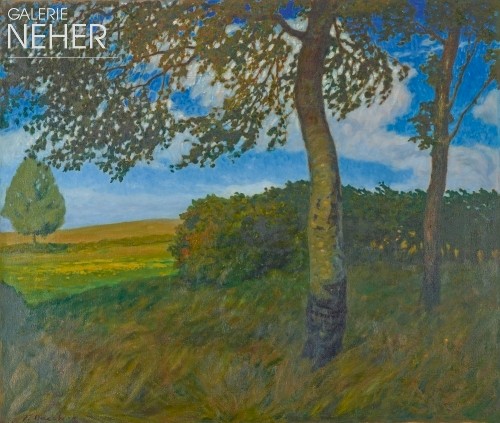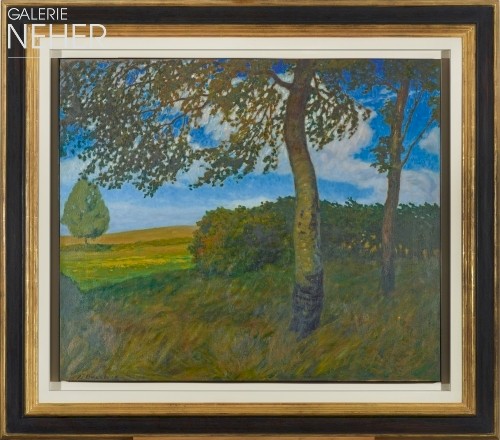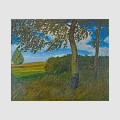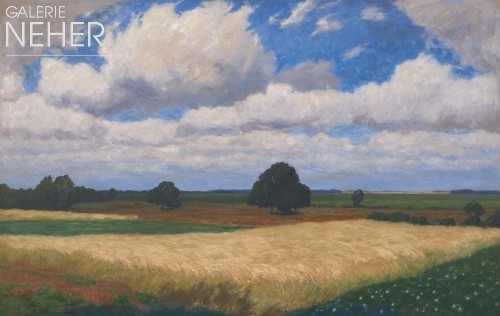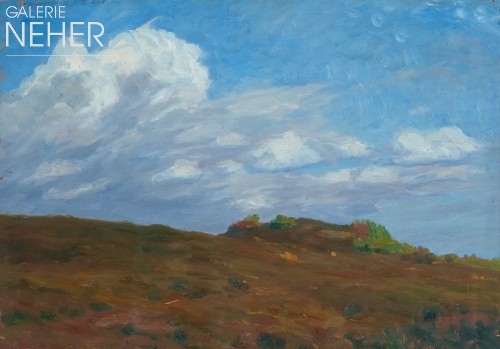Fritz Overbeck - Die Pappel (The Poplar), 1903
Oil on canvas
76 x 91 cm / framed 104 x 117 cm
29 x 35 inch / framed 40 x 46 inch
Signed bottom left "F. Overbeck"
– with handmade craftman’s frame –
N 9160
32,500 €
Expertise:
Expertise Gertrud Overbeck (grandchild) August 6, 2015,
ergänzenden Brief vom 11.11.2015
Provenance:
Verkauft in Worpswede 1912
Privatbesitz
Catalogue raisonné:
Fritz Overbeck, Das Werkverzeichnis - Gemälde auf Leinwand, Werkverzeichnis Nr. 1903/3 mit Abbildung Seite 42
Exhibitions:
Essen, Galerie Neher, Herbst-Winter 2022/2023, Katalog mit farbiger Abbildung Seite 35
Fritz Overbeck - Die Pappel (The Poplar), 1903
Oil on canvas
76 x 91 cm / framed 104 x 117 cm
29 x 35 inch / framed 40 x 46 inch
Signed bottom left "F. Overbeck"
– with handmade craftman’s frame –
N 9160
32,500 €
Expertise:
Expertise Gertrud Overbeck (grandchild) August 6, 2015,
ergänzenden Brief vom 11.11.2015
Provenance:
Verkauft in Worpswede 1912
Privatbesitz
Catalogue raisonné:
Fritz Overbeck, Das Werkverzeichnis - Gemälde auf Leinwand, Werkverzeichnis Nr. 1903/3 mit Abbildung Seite 42
Exhibitions:
Essen, Galerie Neher, Herbst-Winter 2022/2023, Katalog mit farbiger Abbildung Seite 35
About the work
From the cool shadows of the foreground, our gaze glides into the sun–bathed splendour of a radiant summer's day. The soft summer breeze whistles through the leaves of two soaring trees. A lone tree to the left of the picture then directs our gaze into the background. From the right, a hedge intrudes into the image, and, like a dark barrier, conceals the view of the horizon. The blue sky crowns the undulating meadow with innocuous puffs of cloud.
This enchanting scene, rendered in 1903 by the painter Fritz Overbeck, shows the vast and open untouched landscape surrounding the village of Worpswede, and is entitled evocatively "A Summer's Breeze” (subtitled according to the catalogue raisonné: "The Poplar").
Exemplary for the unorthodox perception of nature among the Worpsweder colony of artists, the painter, who settled here in 1894, focuses on an unspectacular extract of nature. As if observed almost in passing, Overbeck captures the immediate optical impression with an apparently spontaneous visual language. Both his approach to the motif and his dynamic brushwork illustrate the characteristic impulses driving Overbeck, who was influenced by the open–air painting of the French Impressionists. The generally muted palette, leavened only by a few patches of bright colour, reveals the academic training undergone by the artist in Düsseldorf around 1890. Formally speaking, however, the expressive light–dark contrasts and the tension–filled composition, with its abrupt shifts between near and far, surface and space, reinforce the potency of the painting's statement. The viewer is drawn ineluctably into this special atmosphere of primeval nature and into the artist's intensive inner emotions triggered by this vibrant summer scene. Thus the large–format painting is suffused with its own distinctive character and the contemplative beauty of Worpsweder's natural landscape.
(Andreas Gabelmann)
Text authored and provided by Dr. Andreas Gabelmann, Art Historian
Dr. Andreas Gabelmann, art historian, born 1967 in Landau. Programmes of study in art history, architectural history and literature in Karlsruhe and Bamberg. 1999 Doctoral thesis on the Badenese Expressionist August Babberger (1885-1936). 2000 to 2002 Practical training at the Brücke-Museum Berlin. 2003 to 2004 Scientific staff member of the Städtisches Kunstmuseum Singen. Since 2005, active as a freelance art historian, author and curator for museums, art associations, galleries, foundations, artist estates, the press and publishing houses in Germany and Switzerland. Numerous publications on modern art with a focus on Expressionism and extending to contemporary art. Publication of the new catalogue raisonné of the printed graphic works of Erich Heckel (will appear in autumn of 2021). Lives and works in Radolfzell on Lake Constance.
